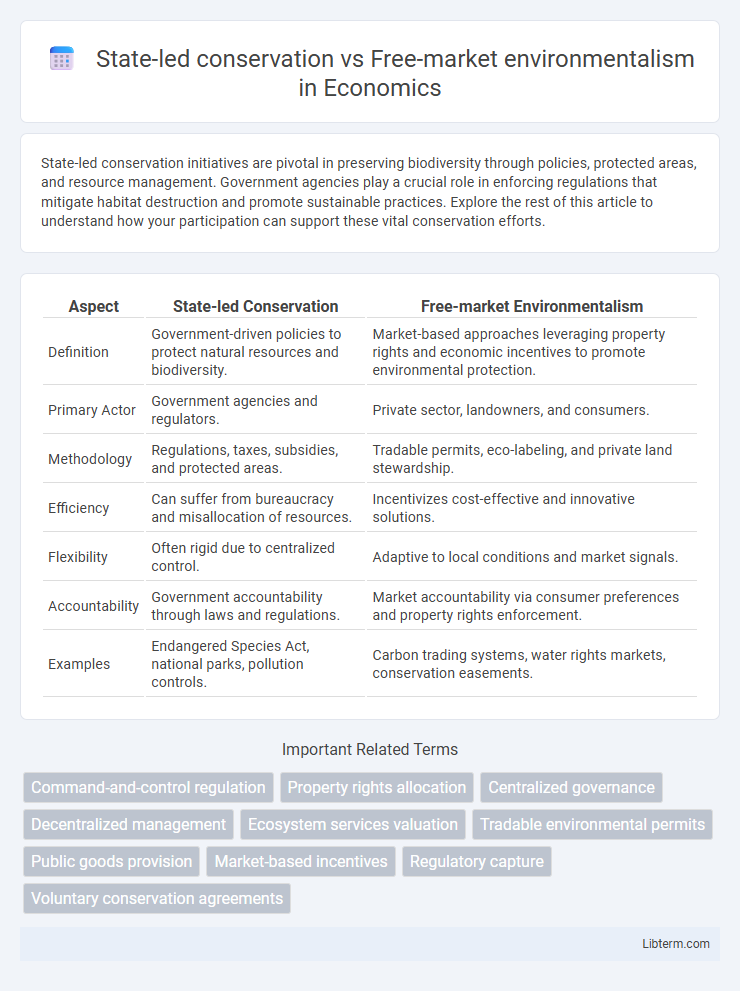State-led conservation initiatives are pivotal in preserving biodiversity through policies, protected areas, and resource management. Government agencies play a crucial role in enforcing regulations that mitigate habitat destruction and promote sustainable practices. Explore the rest of this article to understand how your participation can support these vital conservation efforts.
Table of Comparison
| Aspect | State-led Conservation | Free-market Environmentalism |
|---|---|---|
| Definition | Government-driven policies to protect natural resources and biodiversity. | Market-based approaches leveraging property rights and economic incentives to promote environmental protection. |
| Primary Actor | Government agencies and regulators. | Private sector, landowners, and consumers. |
| Methodology | Regulations, taxes, subsidies, and protected areas. | Tradable permits, eco-labeling, and private land stewardship. |
| Efficiency | Can suffer from bureaucracy and misallocation of resources. | Incentivizes cost-effective and innovative solutions. |
| Flexibility | Often rigid due to centralized control. | Adaptive to local conditions and market signals. |
| Accountability | Government accountability through laws and regulations. | Market accountability via consumer preferences and property rights enforcement. |
| Examples | Endangered Species Act, national parks, pollution controls. | Carbon trading systems, water rights markets, conservation easements. |
Understanding State-led Conservation: Definition and Core Principles
State-led conservation involves government intervention to protect natural resources through regulations, protected areas, and enforcement policies aimed at preserving biodiversity and ecosystems. Core principles include centralized planning, legal frameworks for land use, and public funding to ensure long-term environmental sustainability and equitable resource distribution. This approach emphasizes accountability, environmental stewardship, and balancing economic development with conservation goals.
What is Free-market Environmentalism? Key Concepts and Goals
Free-market environmentalism emphasizes the role of property rights, market incentives, and voluntary transactions in addressing environmental challenges. Key concepts include using economic tools to allocate resources efficiently, reducing government regulations, and encouraging innovation through competitive markets. The primary goal is to achieve sustainable environmental stewardship by aligning individual profit motives with ecological preservation.
Historical Context: Evolution of Conservation Approaches
State-led conservation originated in the late 19th and early 20th centuries, driven by government interventions to protect public lands and natural resources through regulatory frameworks and national parks, reflecting a top-down approach to environmental management. Free-market environmentalism emerged in the late 20th century as a response, emphasizing property rights, market incentives, and voluntary transactions to address environmental problems efficiently with minimal government interference. This evolution highlights a shift from centralized control toward leveraging economic mechanisms and private sector innovation for conservation goals.
Policy Instruments in State-led Conservation
State-led conservation primarily employs regulatory mechanisms, such as protected area designations, species protection laws, and pollution control standards, to safeguard ecosystems and biodiversity. These policy instruments include command-and-control regulations, environmental impact assessments, and government-funded restoration projects, ensuring compliance through monitoring and enforcement. Emphasizing centralized oversight, state-led conservation often relies on statutory frameworks to direct land use and resource management, contrasting with market-based incentives typical of free-market environmentalism.
Market Mechanisms and Property Rights in Environmentalism
Market mechanisms in environmentalism leverage economic incentives such as tradable permits, pollution taxes, and payments for ecosystem services to align private interests with conservation goals, promoting efficient resource allocation. Free-market environmentalism emphasizes clearly defined and enforceable property rights, enabling stakeholders to manage and trade environmental resources, thereby reducing overuse and encouraging stewardship. In contrast, state-led conservation relies on regulatory frameworks and government interventions, often limiting market flexibility but aiming to protect public goods and address externalities where property rights are diffuse or unenforceable.
Case Studies: Successes and Failures of State-led Conservation
State-led conservation has achieved notable successes such as the establishment of Yellowstone National Park in the United States, which preserved vast ecosystems and boosted biodiversity through government intervention. However, failures like the displacement of indigenous communities in the construction of India's Narmada Dam highlight the social costs and mismanagement risks associated with top-down approaches. Case studies reveal that while state-led efforts can protect critical habitats, they often struggle with enforcement challenges and political pressures that undermine long-term environmental goals.
Case Studies: Outcomes of Free-market Environmentalism
Free-market environmentalism demonstrates success in cases like the tradable emissions permits in the U.S. Acid Rain Program, which significantly reduced sulfur dioxide emissions through market incentives. In Namibia, community-based conservancies empowered locals to manage wildlife sustainably, leading to increased biodiversity and economic benefits without heavy state intervention. These outcomes highlight how property rights and market mechanisms can drive effective conservation while fostering economic growth.
Economic Efficiency and Environmental Outcomes Compared
State-led conservation typically relies on regulatory policies and government funding to protect natural resources, often resulting in consistent environmental outcomes but sometimes facing inefficiencies due to bureaucratic overhead. Free-market environmentalism leverages property rights and market incentives to promote conservation, enhancing economic efficiency through competitive resource allocation but occasionally risking inadequate protection in the absence of external regulation. Empirical studies indicate that hybrid models combining regulatory frameworks with market mechanisms often achieve superior economic efficiency while maintaining or improving environmental outcomes.
Challenges and Criticisms of Both Approaches
State-led conservation faces challenges such as bureaucratic inefficiencies, limited funding, and potential for regulatory overreach that can hinder local stakeholder engagement. Free-market environmentalism encounters criticisms for relying heavily on market incentives that may not adequately address public goods like biodiversity and climate regulation, risking under-protection of critical ecosystems. Both approaches struggle with balancing economic development and ecological sustainability, often requiring integrated strategies for effective environmental governance.
Toward Integrated Strategies: Finding Common Ground
State-led conservation relies on government policies and regulations to protect ecosystems, while free-market environmentalism emphasizes market incentives and property rights for environmental stewardship. Toward integrated strategies, combining regulatory frameworks with economic tools like tradable permits and conservation easements can align public goals with private interests. This hybrid approach leverages the strengths of both systems to promote sustainable resource management and biodiversity preservation.
State-led conservation Infographic

 libterm.com
libterm.com